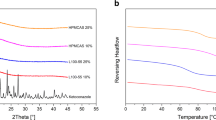Abstract
Purpose. The purpose of this study was to evaluate the physical form of 2-tert-butyl-4-methoxy-phenol (BHA) following wet granulation onto common pharmaceutical excipients.
Methods. A 13C label was incorporated into the methoxy group of BHA, the major isomer in synthetic butylated hydroxyanisole. Solutions of the labeled BHA were used to load the labeled BHA onto common pharmaceutical excipients. After air drying under ambient conditions, the mixtures were examined by 13C MAS and CP/MAS nuclear magnetic resonance (NMR) spectroscopy to evaluate the physical form of the BHA.
Results. The data suggested that BHA could exist as either a crystalline or an amorphous component and that amorphous material was either bound to excipients or relatively mobile during the time of the NMR experiment. At 0.1% loading, BHA appeared to be amorphous and mobile in the freshly prepared blends. At 0.5% loading, BHA was shown to be amorphous on microcrystalline cellulose (MCC) and hydroxypropylmethylcellulose (HPMC) while remaining crystalline on lactose, mannitol, calcium phosphate dihydrate, and croscarmellose sodium.
Conclusions. Solid-state NMR spectroscopy has been used to probe the physical forms of 13C-labeled BHA granulated onto common pharmaceutical excipients. The techniques described in this paper may be applied to help explain stability changes in formulations containing BHA.
Similar content being viewed by others
REFERENCES
H. Verhagen, P. L. Schilderman, and J. C. S. Kleinjans. Butylated hydroxyanisole in perspective. Chem. Biol. Interact. 80:109-134 (1991) and references therein.
J. W. Finley and J. R. Given. Technological necessity of antioxidants in the food industry. Food Chem. Toxicol. 24:999-1006 (1986).
T. R. Kommuru, M. Ashraf, M. A. Khan, and I. K. Reddy. Stability and bioequivalence studies of two marketed formulations of coenzyme Q10 in beagle dogs. Chem. Pharm. Bull. 47:1024-1028 (1999).
L. Chalmers. Antioxidants: research and development report. Soap Perfum. Cosmet. 44:29-38 (1971).
L. R. Mahoney. Antioxidants. Angew Chem. Int. Ed. Engl. 8:547-555 (1969).
L. K. Lam and K. Farhat. The use of pivaloyl chloride in the selective synthesis of 3-tert-butyl-4-methoxyphenol—a BHA isomer. Org. Prep. Proceed. Int. 10:79-82 (1978).
Since there is only one labeled carbon in the BHA and one isomer of BHA present, the three peaks were attributed to the existence of multiple molecules per unit cell. Differential scanning calorimetry, DSC, shows only one transition, an endotherm at 61.8 °C with ΔH of 120.6 J/g.
C. A. Fyfe. Solid State NMR for Chemists. CFC Press, Guelph, Ontario, Canada, 1984.
R. Voelkel. High-resolution solid-state 13C NMR spectroscopy of polymers. Angew. Chem. Int. Ed. Engl. 27:1468-1483 (1988).
Structures of phenols were found in the Cambridge Structural Database using ConQuest v. 1.5 and visualized using Mercury v. 1.1.1.
Handbook of Pharm. Excipients 2000, In A. H. Kibbe (eds.). American Pharmaceutical Association, 3rd ed., 2000, pp. 276–285, 324–327.
Lactose is known to consist of varying amounts of an amorphous component depending on processing and storage conditions, and the two peaks could also result from a facile interaction with the amorphous and crystalline phases, or even from BHA that is “dissolved” in amorphous lactose vs. BHA that is not. Excipient-grade mannitol typically contains small amounts of sorbitol that are believed to reside as an amorphous coating on the crystals, thereby providing beneficial processing characteristics. It is possible that one of the BHA peaks on mannitol results from interaction with this layer.
Author information
Authors and Affiliations
Corresponding author
Rights and permissions
About this article
Cite this article
Remenar, J.F., Wenslow, R., Ostovic, D. et al. Solid-State Nuclear Magnetic Resonance Determination of the Physical Form of BHA on Common Pharmaceutical Excipients. Pharm Res 21, 185–188 (2004). https://doi.org/10.1023/B:PHAM.0000012168.44628.ed
Issue Date:
DOI: https://doi.org/10.1023/B:PHAM.0000012168.44628.ed




